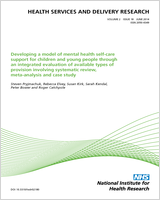NCBI Bookshelf. A service of the National Library of Medicine, National Institutes of Health.
Atherton H, Brant H, Ziebland S, et al. The potential of alternatives to face-to-face consultation in general practice, and the impact on different patient groups: a mixed-methods case study. Southampton (UK): NIHR Journals Library; 2018 Jun. (Health Services and Delivery Research, No. 6.20.)

The potential of alternatives to face-to-face consultation in general practice, and the impact on different patient groups: a mixed-methods case study.
Show detailsIn many areas of their lives, people use the telephone, e-mail, internet videos and social media to communicate. These forms of contact can be more convenient than meeting face to face, but health care has been slow to change. Most general practice consultations still occur face to face. Our research aimed to understand why, how and with what consequences some practices have tried using the telephone, e-mail or internet-based systems alongside face-to-face consultations. We looked at different kinds of health problems, patients and practices within big cities and more rural areas, serving different populations.
Researchers spent time in eight practices across the UK. The practices were selected because they were using alternative forms of consultation. Researchers observed and interviewed staff and patients about their experiences of using alternative forms of consultation.
We found that telephone consultations were common. However, very few practices offered other alternatives, and those that did used them infrequently. This was often contrary to practice expectations. Patients and staff generally liked the convenience of consulting by telephone or e-mail, but only in certain situations, such as familiar ongoing treatment or to exchange simple information. Face-to-face meetings were preferred for infant illness, new or complex problems. General practice staff were not always aware of what alternatives their colleagues were using or why. Practices did not always record the mode of alternative consultations consistently, and some types needed extra administrative effort, which could lead to hidden work. Patients were not always aware of alternative ways of consulting and how they work and, in some cases, had little choice about whether or not they consulted with their doctor using an alternative.
The findings were used to develop a website resource that could be used to guide general practices that are considering introducing alternative forms of consultation. We also devised a framework to guide future research in this area.
- Plain English summary - The potential of alternatives to face-to-face consultati...Plain English summary - The potential of alternatives to face-to-face consultation in general practice, and the impact on different patient groups: a mixed-methods case study
Your browsing activity is empty.
Activity recording is turned off.
See more...